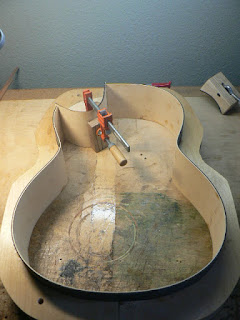I completed side assembly. I have been using solid linings for the top side. Solid lining has three layer laminate configuration using Spanish ceder-Yellow ceder-Spanish ceder combination. For the cut-a-way portion, I made a one piece lining using Mahogany. All solid linings at the top side are able to hold the top very well. Solid lining makes much crispier tonal character, because the solid linings are able to hold the sound board much stronger than conventional kerfed linings. Stronger top support helps to generate stronger over tones. For the back side, I have been using conventional kerfed linings to minimize the guitar weight. Back side does not need strong support for the back board, because the back board is not actively contribute to the tonal character difference. After complete the side assembly, I applied three layers of Shellac with 400-grit sanding. I seal inside of the body completely for better moisture stability. Also, very clean surfaces contribute sound quality improvement. Therefore, I removed all of irregularities inside the body as much as possible.
Kohei Fujii Guitars
Sunday, November 29, 2015
Sunday, November 15, 2015
Side material cut and block making
Side material laminate was completed last week. I cut side material precisely for fitting the mold. This process requires very detailed and precise cutting and adjustment to get perfect fit to inside the mold. I also completed neck and bottom block making. Tail block has a laminate configuration using different grain direction. Spanish ceder has horizontal grain and Rosewood veneer has vertical grain. This combination makes a lightest and strongest block. Neck block also will be added a vertical grained rose wood veneer for the reinforcement. Next week, I will assemble all blocked inside sides.
Sunday, November 8, 2015
Side bending and laminate
Side bend and laminate works have been done this week. Laminate is for Brazilian RW and Yellow ceder. Brazilian RW was sanded to 1.7mm, and Yellow ceder was sanded to 1.2mm. Those sanding processes are including 220-grit final sanding. Both surfaces are clean and smooth for the good Epoxy gluing quality for the laminate. I have been using the laminated sides for material stability and hard and rigid side structure. Brazilian RW quite often have a clacking issue due to the old growth material. So, the laminate side must be used for the Brazilian RW for me. I also finished the bending and lamination for the cut-a-way portion.
Sunday, November 1, 2015
Brazilian Nylon
In my new work shop, I have been working quite effectively for the new Brazilian Nylon model built. I installed White-Black-White inlay in the back. I do not use a sandwich style back inlay that install a center strip when make a book matched back. Sandwiched back is not stable for me. I always make a channel for the center strip inlay install. This process requires extra time. However, this makes a much stable back. I also installed a center patch for the back. Patch material is Mahogany. As usual, I have been using the vacuum clumping technique. On the top, an offset sound hole was made. I also installed an African black-wood sound hole trim. Next week, I will make back and top lattice bracing.
Subscribe to:
Posts (Atom)

















